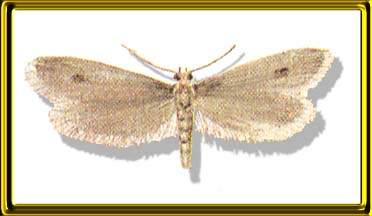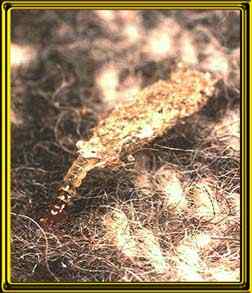
(Case Bearing Clothes Moth)
In the United Kingdom, the casemaking clothes moth is much less important than the webbing clothes moth as a pest. It can be found throughout the country, but is most common in the southern states. It is particularly capable of damaging hair and feathers, but will also feed on spices, tobacco, hemp, and skins. The moth derives its common name from the small silken case that the larva spins about its body and carries about wherever it feeds, thrusting its head and legs out in front (see picture below). Sometimes in a severe infestation, larvae may crawl up on a wall in large numbers, dragging their cases behind them.
Description:
Adult casemaking clothes moths have a 1/2-inch wingspread. The adult is somewhat smaller and more brownish than the webbing clothes moth, and has 3 dark spots on the wings, but the spots become less discernible if the wing scales are worn off. Hind wings are smaller, lighter, and fringed with hair and scales. The males are smaller and lighter in colour than the females, and are active fliers. The females are sluggish, and fly only for short distances. The first thoracic segment of the larva, at first brown, later becomes black, and is divided by a longitudinal band.
Biology:
Females live about 30 days and lay 100 to 300 eggs. The larva stage lasts 50 or more days, and the pupal stage is passed in the case or cocoon. There are about 2 generations a year. The larva can turn within its case and feed on food material at either end without altering the position of the case. If the case is removed from the larva when it is very near pupation, the larva will die. Rarely will the larva spin a web directly on the material on which it is feeding, but will usually attach its case to the material by means of silken threads. Pupation takes place within the case after both ends have been sealed with silk. There were found to be 3 or 4 generations a year at 26 ° ± 8 °C (79 °F) and 82% ± 10% relative humidity when larvae were fed on woollen fabrics impregnated with 5% yeast (CChem, 1956).
Control and Treatment:
The best way to combat carpet beetles and clothes moths is to prevent them from becoming established in the home. The principal weapon is the vacuum cleaner and its brush attachment. Rooms should be cleaned often enough to prevent the accumulation of lint, hair, and other carpet beetle and clothes moth food materials. Close attention should be given to rugs and carpets, draperies, upholstered furniture, closets (especially those containing woollens and furs), radiators and heaters, corners, cracks, baseboards, mouldings, and other hard-to-reach places. If an infestation is known or suspected, the sweepings of the vacuum cleaner should be disposed of immediately in such a way as to destroy the insects, to prevent a transfer of infestation from one part of the house to another.
Abandoned nests of birds, rodents, and insects, (particularly bees and wasps) that are in or near the house should be removed, for the larvae of both carpet beetles and moths may feed on insect remains that they may contain. Bedding places of pets should be kept clean. Mounted animal specimens or trophies (or even fur-covered toys), insect collections, stored woollens, carpeting, clothing, feathers, furs, old spices, cereals, or seeds should be examined for signs of infestation. The attic and garage should be included in the inspection. Avoid bringing carpet beetle adults into the house on cut flowers, where they are sometimes found feeding on pollen.
Cedar-lined chests and closets are not 100 percent effective. The natural cedar oil evaporates and a fresh treatment of cedar oil should be applied every two years. Be sure that all cloth goods be dry cleaned, washed, pressed with a hot iron, sunned, or brushed prior to storage in an airtight container with an effective moth repellent.
If the infestation is particularly bad, you may have to call in a pest controller but don't be persuaded into having a contract. Usually a Job treatment of three or four visits is enough to get on top of the problem. A general spray, once the infested material has been removed, in the problem area and also the areas adjacent, in case any have gone walkabout. Infested stuffed furniture and other salvageable commodities should be fumigated by a licensed pest control operator or applicator. Before using any insecticides, always read the label directions and follow safety precautions.
Back to main Textile Pests page
